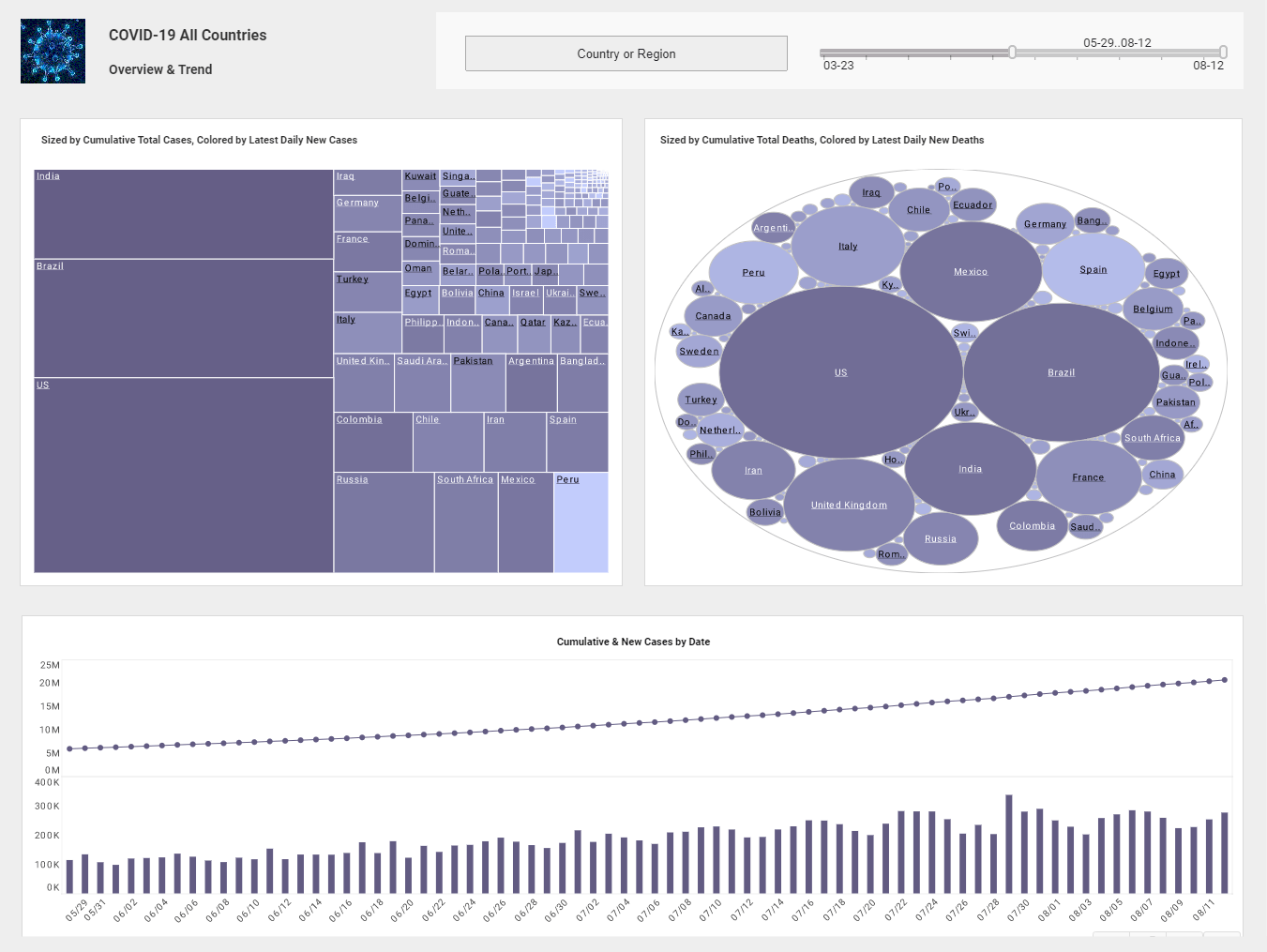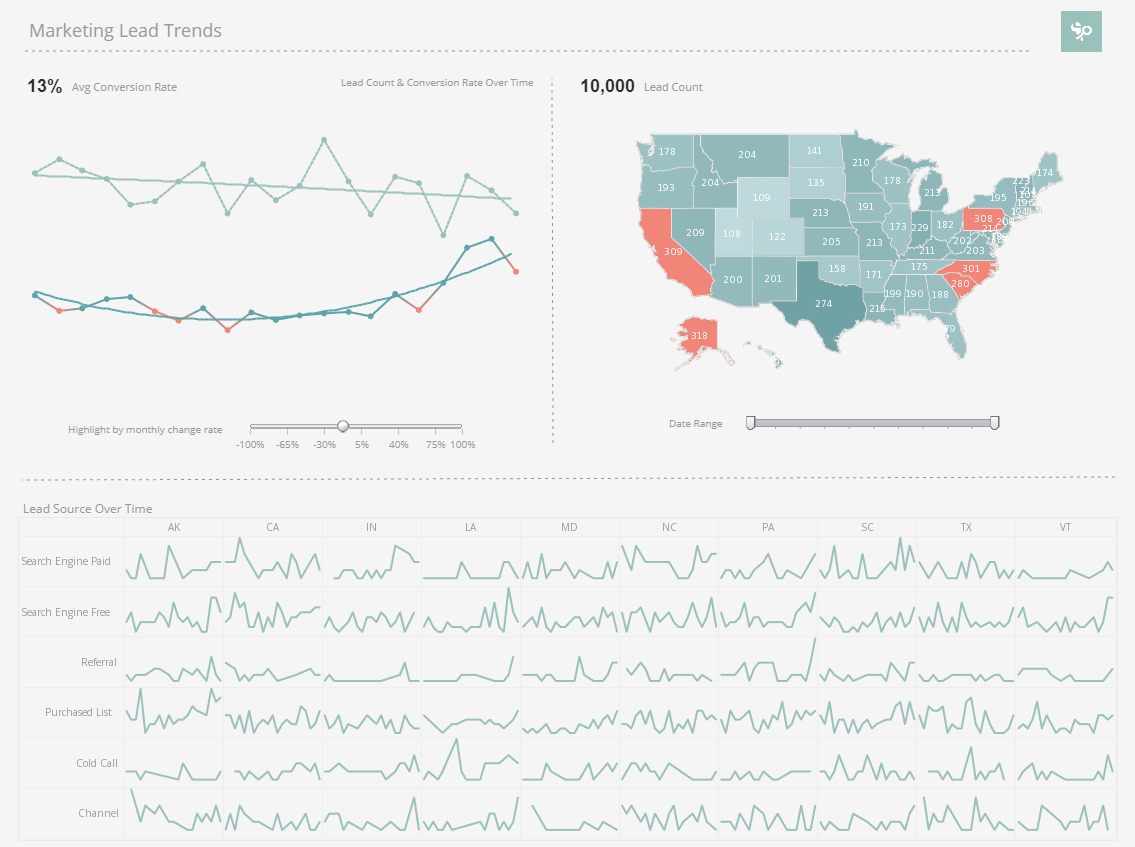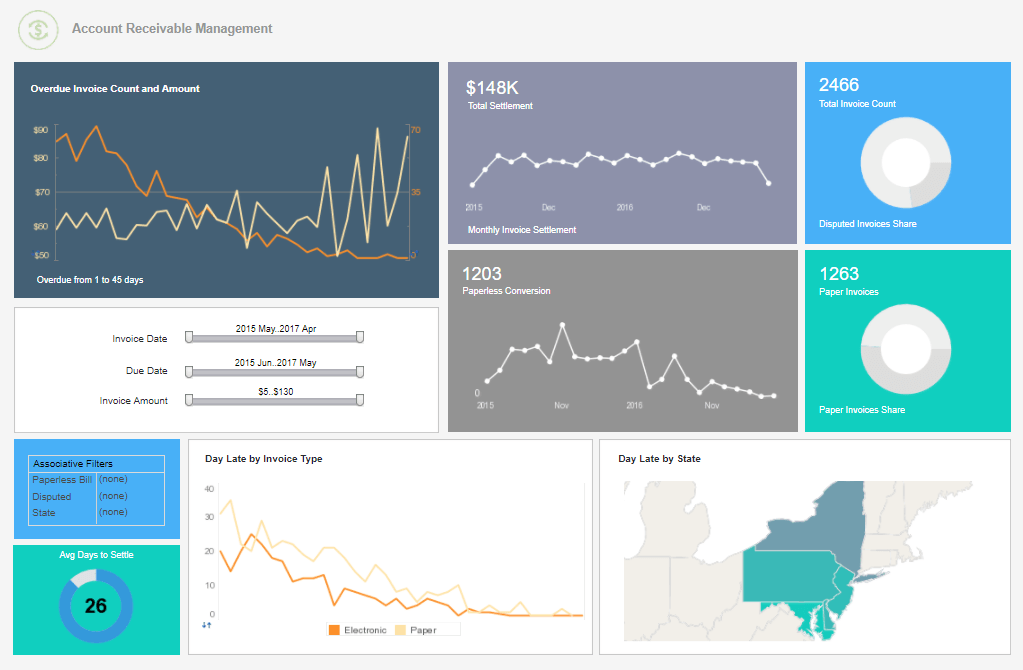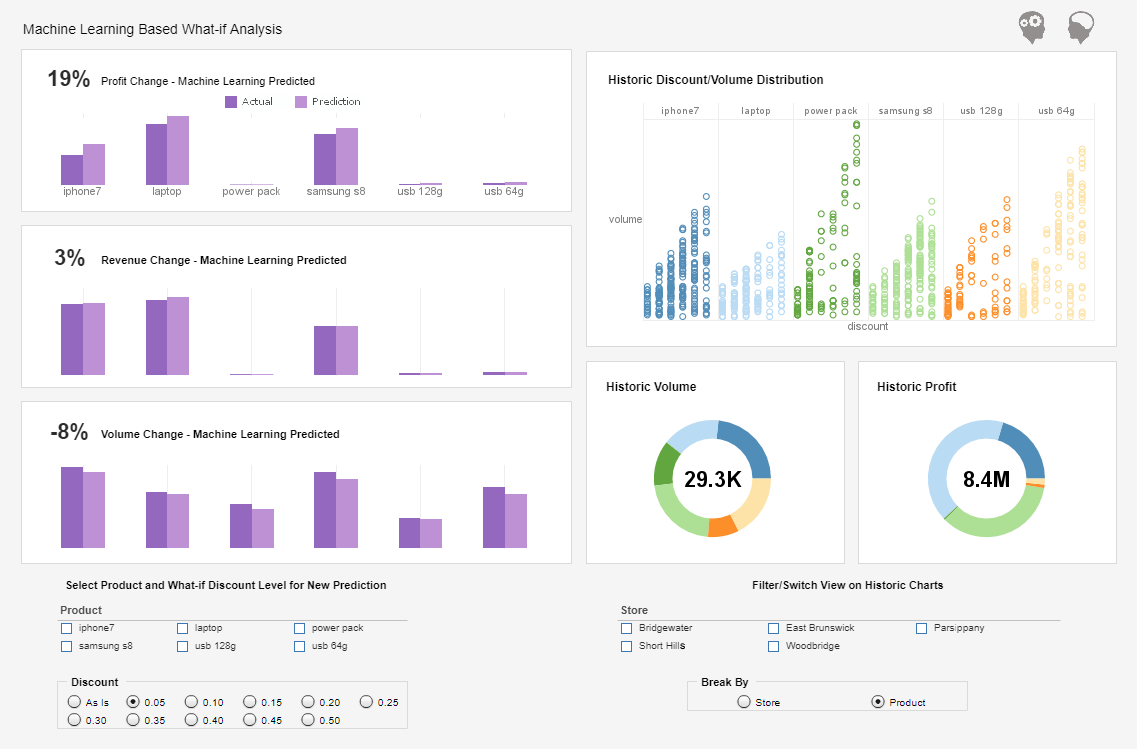Big Data Companies: InetSoft Technology
Deciding among alternatives for your Big Data infrastructure?
As a solution that adheres to the open-source standards, InetSoft's StyleBI will be compatible with whatever company that you choose for storing massive data sets. Style Intelligence enables visual dashboarding and the performance of sophisticated analytics on Big Data, all performed at high speeds, thanks to InetSoft's Data Grid Cache.
In addition to the tools within a third-party database platform, InetSoft's compatible and versatile BI solution will cater to your users with powerful data mashup, detailed reports, and interactive dashboards, all within an intuitively easy interface. Style Intelligence is an easy, agile, and robust BI software application that will complement any data source, large or small.
We have evaluated and compiled a list of distinctive companies to consider for managing your Big Data needs. All of these can be integrated and mashed up with more traditional sources, using InetSoft's big data solutions.

Amazon - AWS (Amazon Web Services) offers primary tools to help with data computation and sharing; users also have the option to utilize additional tools for Hadoop and NoSQL data stores. Solutions such Amazon Simple Storage Service (S3), Amazon Elastic Block Store (EBS), and Amazon DynamoDB are available for petabytes of data storage. Users can effortlessly store and transfer their Big Data collection to and from the cloud using transfer services such as Import/Export service or AWS Direct Connect. AWS offers primary tools to help with data computation and sharing; users also have the option to have additional tools for Hadoop and NoSQL data stores.
Cloudera - Each on varying licensing terms, Cloudera offers one edition of Cloudera Express and three editions of Cloudera Enterprise (Basic, Flex, and Data Hub). The foundation of these products is CDH, which is an open source Apache-licensed software that enables Hadoop-style architecture. HBase, Impala, Cloudera Search, Apache Spark and Cloudera Manager are all examples of data management components that help organize Big Data to help facilitate solutions.
Google - Google enables interactive Big Data analysis via a cloud platform with BigQuery. With an easy-to-use interface, this web-based architecture allows users to rapidly request SQL-like queries, and promptly access historical and real-time data. Companies with multiple positions and levels will appreciate the accessibility of separate interfaces, so that their users are provided with the data tools that they find necessary. Google provides flexible pricing for BigQuery, requiring payment only for the storage users need and the queries that they run.
MemSQL - Provisioning Big Data, MemSQL's database is structured as a tiered storage, which features an in-memory store and a flash or disk-based column store. The product allows data to be moved from memory to flash to disk, and effortlessly transfers data between storage engines. Users can run SQL queries as sophisticated as JOINS and work with JSON in a relational environment. The database also features ANSI SQL interfaces and uses MySQL client drivers, ODBC, and JDBC. MemSQL offers the option to house the data on premise, host in public, or via a private cloud
MongoDB - As a NOSQL open-source database, MongoDB prides itself as an agile and flexible platform fit for Big Data. The horizontal scaling product, MongoDB Enterprise, is an in-memory computing database. It enables JSON-like documents with versatile schemas to support instantaneous changes. Users are still equipped with the familiar components of traditional databases such as detailed consistency, comprehensive query language, and secondary indexes.


Using StyleBI to Decode Interspecies Communication in the Deep Ocean
Studying marine animal communication in the deep ocean is not a simple task. Researchers rely on autonomous underwater vehicles (AUVs) equipped with hydrophones, sonar, and bioluminescence sensors to capture raw acoustic and behavioral data from species interactions. These AUVs log terabytes of audio signals, location coordinates, water salinity and temperature, 3D movement trajectories, and even fluorescence data from organisms like squid. Complementing this are satellite telemetry records tracking the migration of large marine mammals like whales and ocean current models gathered from NOAA databases.
All this data is rich but extremely diverse—spanning different formats, resolutions, and temporal windows. Integrating and analyzing this oceanic "big data" to detect patterns in cross-species communication is a data engineering challenge of a rare and complex kind. The traditional data warehouse model breaks down under such volume, variability, and irregularity. StyleBI’s schema-less data mashup capability allows scientists to sidestep these constraints and focus directly on insight discovery.
StyleBI's Role in the Deep Sea
StyleBI is engineered for scenarios that require the fusion of data from numerous unstructured or semi-structured sources without the rigidity of ETL processes. For marine biologists working on decoding interspecies communication, this means they can import acoustic waveforms, behavior annotations, real-time satellite feeds, and sensor metadata into a single visual analytics environment. Data can be connected using StyleBI’s mashup layer, which supports streaming inputs and federated queries across cloud storage, APIs, and relational systems.
This allows researchers to correlate seemingly disparate data—such as a specific pattern of whale song with a spike in squid luminescence or evasive movement—without having to harmonize data formats manually. By linking these signals over time and geospatial coordinates, StyleBI becomes a hub for hypothesis-driven exploration.
Visual Pattern Recognition in a Biological Context
One of the central goals of this kind of research is to identify recurring sequences in audio or movement data that may indicate intentional signaling between species. With StyleBI’s visual dashboarding capabilities, researchers can build dynamic heatmaps, time-series analyses, and 3D scatter plots to explore these patterns. For example, they can visually overlay whale dive profiles with squid burst movements to see if avoidance or approach behavior is consistent across multiple encounters. They can animate frequency domain transformations of whale vocalizations in tandem with synchronized motion footage captured by underwater drones.
These dashboards are not static; they are interactive exploration tools. A marine biologist can zoom into a five-second audio clip, match it with sonar pings and AUV depth readings, and compare it with previous encounters—all without exporting data to another platform. This enables rapid, iterative analysis and collaborative model development among cross-disciplinary teams.
Streaming Data and Real-Time Observation
Because AUVs and satellites continuously stream new data during research expeditions, real-time visualization becomes essential. StyleBI allows for the direct integration of live data feeds. As AUVs patrol a designated marine corridor, incoming acoustic events and telemetry data can be streamed into StyleBI and displayed on evolving dashboards. Researchers on deck—or even remote collaborators—can watch for anomalies or rare events, such as coordinated turns between species or abrupt sound bursts associated with proximity events.
This real-time capability is not only useful for immediate analysis but also for triggering deeper exploration. For example, if a unique vocal pattern is detected, the system can trigger a zoom-in on all contextual environmental variables at that moment, or alert another AUV to focus on that region. StyleBI’s built-in support for live mashups and threshold-based alerting supports this level of responsiveness.
Row-Level Security for Data Stewardship
Marine research often involves multiple organizations—academic institutions, governmental agencies, NGOs, and even indigenous groups with protected access to marine ecosystems. Each stakeholder may have different permissions to access various parts of the data. StyleBI’s row-level security features make it possible to build a unified analytics platform while tightly controlling what each user can see.
For instance, a university research team may only be allowed to analyze acoustic data within a designated marine protected area, while an international agency may have access to movement patterns across the entire Pacific corridor. These access rules can be enforced dynamically within StyleBI without duplicating datasets or rebuilding models, ensuring both compliance and efficiency.
Pairing with AI for Signal Decoding
Machine learning and AI play a key role in this type of research, particularly for signal decoding and pattern classification. Models trained using Python or TensorFlow can be used to label sections of audio as potential “calls,” “echolocation,” or “click trains,” and these predictions can be visualized directly within StyleBI dashboards. Rather than building separate data pipelines, researchers can use StyleBI to compare the output of different models in context with environmental and behavioral data.
This enables hypothesis testing at the visual level—does a specific ML-flagged “communication event” coincide with changes in depth, salinity, or motion? Are certain sequences more common during spawning season? These types of questions are far easier to answer when machine-generated labels are integrated directly into the visual analytics flow.
React Integration for Public Science Platforms
Public engagement and scientific transparency are becoming more important in conservation work. By embedding StyleBI dashboards into React-based public portals, marine labs and conservation groups can let the public explore safe, anonymized slices of data. Visualizations of migration routes, audio maps of vocal diversity, or luminescent activity over coral reefs can become powerful tools for education and advocacy.
StyleBI’s embeddable dashboards and API integration allow developers to build interactive data journeys for non-specialist audiences while still benefiting from enterprise-grade analytics on the backend. With minimal front-end engineering, the ocean can be opened to curious eyes around the world.
InetSoft Big Data Articles
-
Data Grid Cache
This article highlights how InetSoft’s Data Grid Cache combines in‑memory and disk‑based technology to deliver fast analytics from large-scale sources like Hadoop, Cloudera, and SAP HANA. It explains how StyleBI enables drag‑and‑drop mashups across disparate big data systems and relational sources. Users can achieve real‑time insight without complex ETL processes. -
City Big Data
This post outlines how InetSoft’s unified big data solution can help cities fuse data from multiple agencies to create actionable, self‑service visual analytics. It showcases use cases like correlating transportation, weather, and social media for policy and planning. It emphasizes usability for municipal governments without heavy technical overhead. -
Native Big Data
Describes StyleBI’s ability to natively run inside Hadoop/Spark as an analytics engine rather than just connecting externally. It allows mashups, dashboards, and machine learning directly within the Big Data OS without data extraction. This simplifies deployment and reduces latency by processing data where it resides. -
Big Data Manipulation
Explains how StyleBI can access and blend data from Hadoop, Spark, MapR, SAP HANA, spreadsheets, and databases in one unified environment. Its mashup engine removes the need for rigid schema or data warehouse design by bringing data together visually. Users manipulate and analyze big datasets through user‑friendly drag‑and‑drop workflows. -
Easy Big Data Path
Introduces InetSoft’s cloud‑ready, scalable platform that can connect to existing Big Data sources or deploy its own Spark/Hadoop cluster as an all-in-one solution. It promises minimal setup and no need for specialized Big Data expertise, making analytics accessible to general IT staff. Visual mashups and dashboards are available immediately for users without long lead times.



